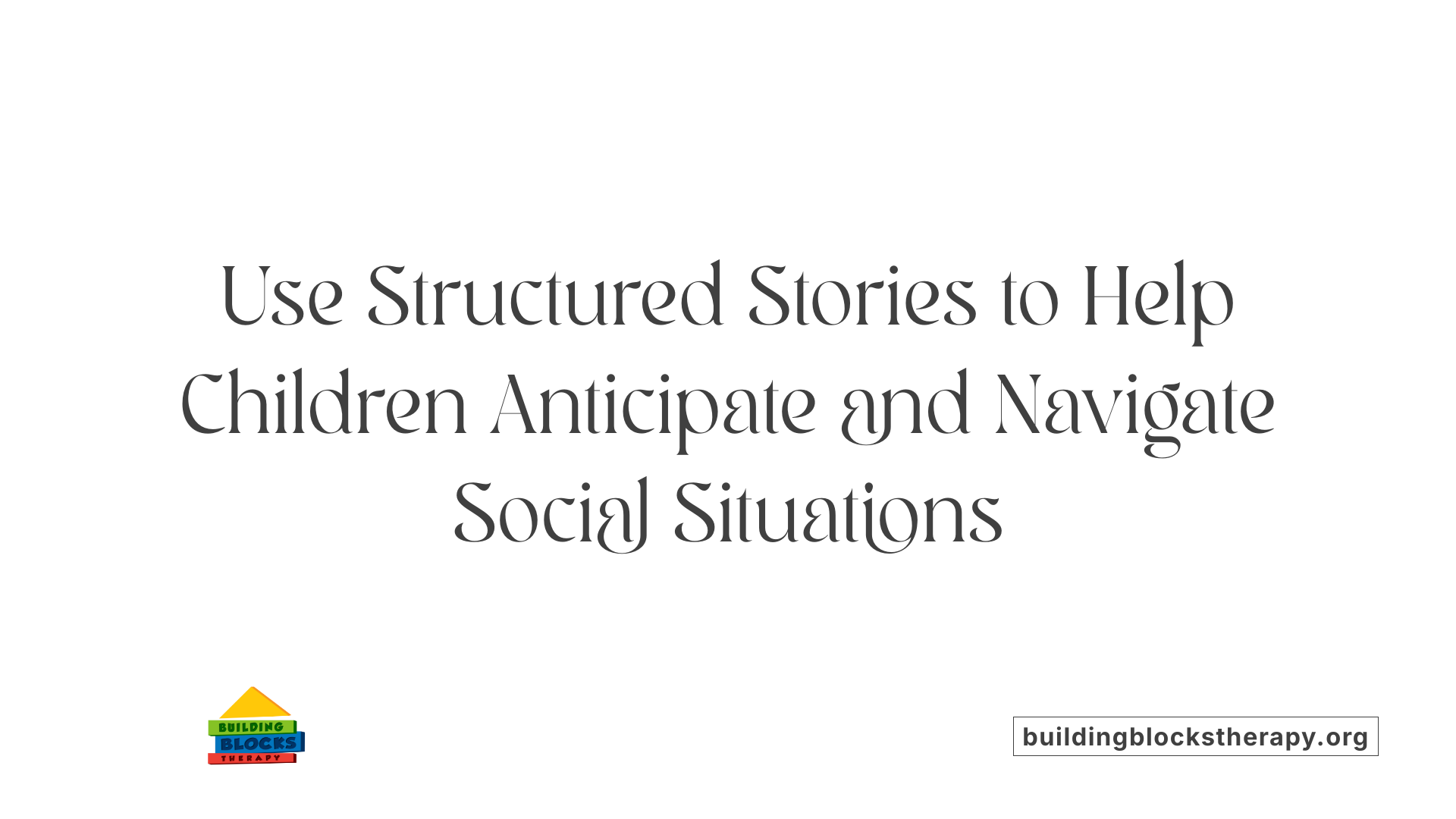Understanding the Effectiveness of Social Stories in Autism Support
Social stories are a versatile and evidence-based intervention that supports individuals with autism spectrum disorder (ASD) by helping them understand social environments, develop emotional regulation, and foster positive behaviors. Developed by Carol Gray in the 1990s, these personalized narratives use simple language and visual supports to make social situations less confusing and more manageable for children and adolescents. This article explores the benefits, scientific backing, and best practices for creating and using social stories as a critical tool in autism support.
What Are Social Stories and How Do They Support Individuals with Autism?

What are social stories and how do they support individuals with autism?
Social stories are brief, personalized stories that describe social situations, expected behaviors, and social cues using simple language and visual supports like pictures or diagrams. Developed by Carol Gray in the 1990s, they aim to help individuals, particularly children and adolescents with autism spectrum disorder (ASD), understand complex social interactions.
These stories break down social norms into manageable steps, making it easier for children to grasp what to do in different scenarios. They include descriptive sentences about what is happening, perspectives of others, and explicit instructions on how to behave. This structured approach builds social understanding and supports the development of emotional and social skills.
How do pictures and clear language enhance their effectiveness?
Visual supports, such as photographs or drawings, are integral to social stories. They make abstract social concepts more concrete, which is particularly helpful for children with language delays or difficulties understanding verbal instructions.
The language used in social stories is straightforward, positive, and literal, ensuring clarity and avoiding confusion. Combining visuals with clear sentences helps children recognize social cues, interpret emotions, and understand how their actions affect others.
How they assist in understanding and managing anxiety
Social stories can significantly reduce anxiety by preparing children for upcoming events or changes. For example, a social story explaining a trip to the dentist can include what to expect, how the environment looks, and how to behave, which can lessen fear and uncertainty.
Reading these stories multiple times helps children anticipate situations, gain confidence, and develop self-regulation skills. This preparedness promotes feelings of safety and control, decreasing distress during new or challenging experiences.
Their use in preparing for new experiences
Before engaging in new routines, environments, or social interactions, caregivers or professionals can introduce a social story. This helps children understand what will happen, what is expected of them, and how to respond appropriately.
For instance, stories about starting school or visiting a new place guide children through the sequence of events, easing transitions and encouraging independent participation. They are effective when tailored to individual needs and preferably read several times beforehand.
| Aspect | Description | Additional Notes |
|---|---|---|
| Purpose | Describe social situations, teach behaviors | Used across settings like home, school, and community |
| Effect | Reduce anxiety, improve understanding | Helps with transitions and social participation |
| Format | Personalized narratives, visual supports | Can include pictures, videos, or music |
| Key Components | Descriptive, perspective, directive, positive | Followed by review and practice |
Social stories are versatile tools that facilitate social growth, emotional understanding, and behavioral regulation. When personalized and used consistently, they become a vital part of supporting individuals with autism in navigating their social world.
The Benefits of Social Stories for Social, Emotional, and Behavioral Development
What benefits do social stories offer for social, emotional, and behavioral development in children and adolescents with autism?
Social stories have been recognized as valuable tools to support children and teenagers with autism spectrum disorder (ASD) in their social and emotional growth. One of their main advantages is enhancing social understanding. By breaking down social situations into clear, simple narratives, children learn what to expect and how to act appropriately in various contexts.
These stories also play a significant role in improving communication skills. Children often struggle with understanding social cues and expressing themselves. Through visual and written cues, social stories help clarify social norms, gestures, facial expressions, and conversation patterns, making social interactions more approachable.
Fostering empathy and boosting self-esteem are additional benefits. When children see perspectives of others and understand feelings through story characters, they develop greater empathy. Positive reinforcement within social stories can boost their confidence, encouraging them to participate more actively in social settings.
Moreover, social stories are effective in reducing anxiety and supporting emotional regulation. By preparing children for upcoming events or transitions—like starting school or visiting the doctor—these stories help children anticipate what will happen, decreasing fear and stress.
The adaptability of social stories allows caregivers and professionals to tailor content to meet individual needs. Whether addressing specific behavioral challenges, encouraging self-care routines, or teaching life skills, social stories promote positive behaviors through repetitive practice and reinforcement.
Overall, social stories are a practical, engaging intervention that facilitates overall social growth, emotional resilience, and behavioral improvements, making them integral to autism support programs.
Scientific Evidence Supporting the Use of Social Stories
Research and systematic reviews
Numerous studies and reviews have explored the effectiveness of social stories for children with autism. Systematic reviews and meta-analyses, which evaluate multiple randomized controlled trials (RCTs), provide a comprehensive overview of their impact. These reviews have found that social stories can positively influence social skills by improving understanding of social norms and appropriate behaviors.
Although many investigations are based on individual case studies, recent high-quality trials are beginning to establish stronger scientific support. These include large-scale studies across schools where social stories have been used alongside other interventions.
Effectiveness on target behaviors
Research demonstrates that social stories help in achieving targeted behavioral goals. They are particularly effective in reducing disruptive behaviors such as crying, hitting, or screaming. Additionally, they promote prosocial behaviors like sharing, eye contact, and initiating conversations.
Studies indicate improvements not only in social communication but also in emotional regulation, self-esteem, and empathy. Multimedia formats, like video modeling and musical adaptations, have been shown to enhance learning outcomes further.
Factors influencing outcomes
The success of social stories can depend on several variables. The length, frequency, and intensity of the intervention are important — typically, stories are read multiple times over weeks for best results.
Participant characteristics, including age, severity of ASD, verbal skills, and comprehension levels, influence how well children respond. Children with better understanding and communication skills tend to benefit more. Individualizing stories to fit each child's specific needs is critical.
Trained professionals or caregivers often craft social stories, ensuring they contain structured components such as descriptive, perspective, directive, and affirmative sentences. Incorporating visual supports and involving children in story creation also boost effectiveness.
Limitations and future research needs
Despite encouraging findings, some limitations remain. For example, not all children with ASD benefit equally, especially non-verbal or those with significant comprehension difficulties.
The scientific community notes the need for more rigorous research, especially large-scale RCTs with standardized protocols. Future studies should aim to compare different formats (written, multimedia, musical) and determine long-term outcomes.
Furthermore, research should focus on identifying which children are most likely to benefit and how to tailor social stories optimally. As awareness grows, integrating social stories into broader intervention programs remains a promising but still developing area.
| Aspect | Findings | Notes |
|---|---|---|
| Efficacy | Generally positive | Improves social skills and reduces problematic behaviors |
| Formats | Multimedia, written, musical | Different formats can enhance engagement |
| Influencing Factors | Intervention duration, individual needs | Customization is crucial |
| Limitations | Variable responses, need for more studies | Especially for non-verbal children |
| Future Directions | More high-quality research required | Focus on long-term effects and customization |
Overall, while social stories are supported by accumulating scientific evidence, ongoing research continues to refine their use and maximize benefits for children with ASD.
Reducing Anxiety and Improving Communication Through Social Stories
How can social stories reduce anxiety and improve communication skills in children with autism?
Social stories play a significant role in helping children with autism manage anxiety and enhance their communication abilities. These brief, personalized narratives provide clear, step-by-step explanations of social situations, norms, and expected behaviors. By doing so, they help children understand what to anticipate—a crucial factor that reduces uncertainty and stress.
For children with autism, social cues such as facial expressions, gestures, or body language can be confusing. Social stories break down these complex cues into simple language and visual supports, making social interactions more manageable. As children become familiar with these cues, they gain confidence and are more likely to engage positively with others.
Moreover, social stories emphasize appropriate responses and behaviors, helping children learn how to communicate effectively in various settings. This focus on explicit teaching fosters skills such as initiating conversations, understanding emotions, and responding appropriately—skills that are often challenging for children with autism.
Empowering children with knowledge reduces their anxiety about unfamiliar or stressful situations. When children can anticipate what will happen and understand how to behave, their confidence increases.
Research evidence shows that interventions incorporating social stories—including digital formats like multimedia stories or videos—can lead to meaningful reductions in anxiety levels. These stories help children develop better social understanding and communication skills, which are vital for their social participation and emotional well-being. The positive effects are often maintained over time, indicating the lasting value of social stories.
Overall, social stories serve as effective tools that support children with autism by reducing their anxiety and fostering effective communication, making social interactions less intimidating and more successful.
Best Practices for Creating and Implementing Social Stories
Following Carol Gray’s criteria
Creating effective social stories begins with adhering to Carol Gray’s ten criteria. These include making stories descriptive, focused, and positive, as well as ensuring they are truthful, simple, and personal. Every story should describe specific social situations in a clear and concrete way, providing children with accurate and literal information. Keeping the language straightforward and positive helps children feel encouraged and understood. Visual supports such as pictures or icons are often used to reinforce the content, making stories accessible for children with varied learning needs. Implementing these standards ensures the social story effectively supports social understanding and reduces anxiety.
Identifying goals and relevant topics
The initial step involves pinpointing specific social or behavioral goals. Whether it’s learning how to greet others, understanding personal space, or managing transitions, clarity here is essential. Once goals are set, select topics that are meaningful and relevant to the child’s everyday experiences. For example, if a child struggles with sharing, the story could focus on sharing during playtime. Setting a well-defined objective directs the story’s content, helping the child develop targeted skills or behaviors.
Involving children in the process
Engagement enhances the effectiveness of social stories. Children should actively participate in creating and practicing their stories. This might include choosing pictures, suggesting phrases, or acting out scenarios. Role-playing and repeated reading sessions help reinforce learning and build confidence. Involving children reduces their anxiety by giving them a sense of control and ownership over the process. It also ensures that stories are personalized, relevant, and more likely to be understood and remembered.
Using visual supports
Visual supports are vital to the success of social stories, especially for children with communication or sensory processing challenges. Incorporate photographs, drawings, or simple graphics that illustrate key social cues like facial expressions or gestures. Visual aids help children connect the words with real-life images, enhancing comprehension and retention. When combined with verbal stories, pictures support dual coding—processing information visually and verbally—which can improve outcomes for a wide range of learners.
| Step | Focus | Tips | Additional Notes |
|---|---|---|---|
| 1. Goal Setting | Define specific skills or behaviors | Keep goals clear and measurable | Use information from caregivers or teachers |
| 2. Selecting Topics | Relevance to child's daily life | Focus on common social situations | Prepare for upcoming events |
| 3. Story Creation | Follow Gray’s criteria | Use simple language, positive tone | Personalize with child's name and pictures |
| 4. Visual Support Integration | Add relevant images | Include photographs or drawings | Use clear, simple visuals |
| 5. Child Involvement | Participation in creation and rehearsal | Role-play scenarios | Encourage feedback and self-reflection |
| 6. Repetition and Practice | Read regularly | Schedule sessions before events | Reinforce learning through role-playing |
Efficiently creating and applying social stories involves careful planning and customization. By carefully selecting goals, engaging the child, and employing visual supports, caregivers and educators can significantly improve social understanding and behavior. Regular review, updates, and practices ensure that social stories remain a dynamic and effective part of social development strategies.
Supporting Parents and Caregivers in Using Social Stories Effectively
How can parents and caregivers use social stories to enhance social understanding in children with autism?
Parents and caregivers can significantly improve social understanding in children with autism by utilizing personalized social stories. These stories are tailored to explain specific social situations, expectations, and appropriate responses in clear, simple language. Incorporating visual supports such as pictures or illustrations makes the stories more accessible and easier for children to grasp.
A practical approach involves reading the social stories to the child a week or two before a planned event or change in routine. This helps the child to anticipate what to expect, which in turn reduces feelings of anxiety and increases confidence. For example, a story about visiting the dentist can prepare a child for the experience, making the situation less daunting.
Integrating social stories into daily routines is another effective strategy. Regular review and practice reinforce understanding and help children develop better self-regulation and social skills over time. For instance, a social story about sharing during playtime can be revisited routinely to reinforce the behavior.
Involving children in the story creation or retelling process can boost engagement and comprehension. Children often are more motivated to learn when they have a say in how the stories are developed or when they help illustrate or personalize the narratives.
Overall, social stories act as a structured and predictable tool, helping children interpret social cues, improve communication, and better navigate their social environments. When used consistently and tailored carefully, they support children in understanding social norms, managing emotions, and developing confidence in their social interactions.
The Overall Impact and Future of Social Stories in Autism Support
What positive effects do social stories have on understanding behaviors, routines, and social interactions?
Social stories significantly enhance children's grasp of behaviors, routines, and social cues. By offering personalized narratives that clearly outline social situations and appropriate responses, they help children with autism and related challenges better manage transitions and social interactions.
These stories break down complex social expectations into simple, manageable steps, making it easier for children to recognize and respond correctly. This leads to fewer disruptive behaviors and greater engagement in social settings.
Furthermore, social stories contribute to emotional regulation by helping children anticipate what will happen next and understand how others may feel. This understanding fosters empathy, allows for better communication, and boosts confidence.
What makes social stories particularly effective is their adaptability—they can be delivered through physical books, digital media, or apps, and are tailored to individual needs to maximize relevance.
When used consistently, especially before engaging in new or challenging activities, social stories promote positive behaviors and social participation both at home and in school environments.
The importance of individualization and context
Personalization is crucial to the success of social stories. Developing stories tailored to a child’s specific needs, abilities, and goals ensures relevance and engagement.
Creating effective social stories involves identifying key behaviors to teach, understanding the child's unique challenges, and including visual supports or involvement from the child during story creation.
Context also matters. Stories should reflect real-life situations the child is likely to encounter, such as going to the supermarket, visiting the doctor, or sharing during play. This contextual relevance increases the transfer of learned responses to everyday life.
Various settings, such as home, school, or community, demand different story content, highlighting the importance of flexibility and responsiveness in story development.
Need for further research
While current evidence supports the benefits of social stories, ongoing research is essential to enhance their effectiveness. Many studies have shown positive trends, but some results indicate variability based on how stories are created or implemented.
Further research should explore optimal story formats, such as multimedia approaches like video modeling combined with social stories, or music-based adaptations, to determine best practices.
There is also a need to investigate long-term outcomes and how social stories contribute to broader social and emotional development over time. Additionally, understanding how to best adapt stories for children with different levels of comprehension—particularly nonverbal children—remains a priority.
Overall, advancing research will help refine social story techniques, ensuring they remain a valuable, evidence-based tool in supporting children with autism and other developmental conditions.
| Aspect | Details | Additional Notes |
|---|---|---|
| Benefits | Improve understanding of social cues, routines, and behaviors | Supports emotional regulation and confidence |
| Methods | Personalized narratives, visual supports, multimedia formats | Reinforcement through repeated exposure |
| Challenges | Variability in effectiveness, need for individual tailoring | Less effective for children with poor comprehension |
| Future Needs | Research on long-term impacts, multimedia integration | Developing stories for nonverbal children |
Harnessing the Power of Social Stories for Better Outcomes
Social stories have established themselves as a valuable tool in supporting the social, emotional, and behavioral development of children and adolescents with autism. They foster understanding, reduce anxiety, and promote positive behaviors by providing tailored, concrete, and visual information. While current evidence supports their effectiveness, continued research and refinement will enhance their application, ensuring that they meet the diverse needs of individuals on the spectrum. When implemented thoughtfully and consistently, social stories can truly make a meaningful difference, empowering children with autism to navigate their social worlds with confidence and success.
References
- Effects of social stories intervention for children and adolescents ...
- Benefits of social stories for neurodiverse children - RWA Psychology
- [PDF] The Effectiveness of Social Stories among Children and ... - ERIC
- Why Social Stories are so Important for Children with Autism
- Impact of Social Stories on social and emotional health of autism ...
- How to Use Social Stories to Support Your Child - Cortica
- Using Social Stories to Improve Your Child's Understanding ...






